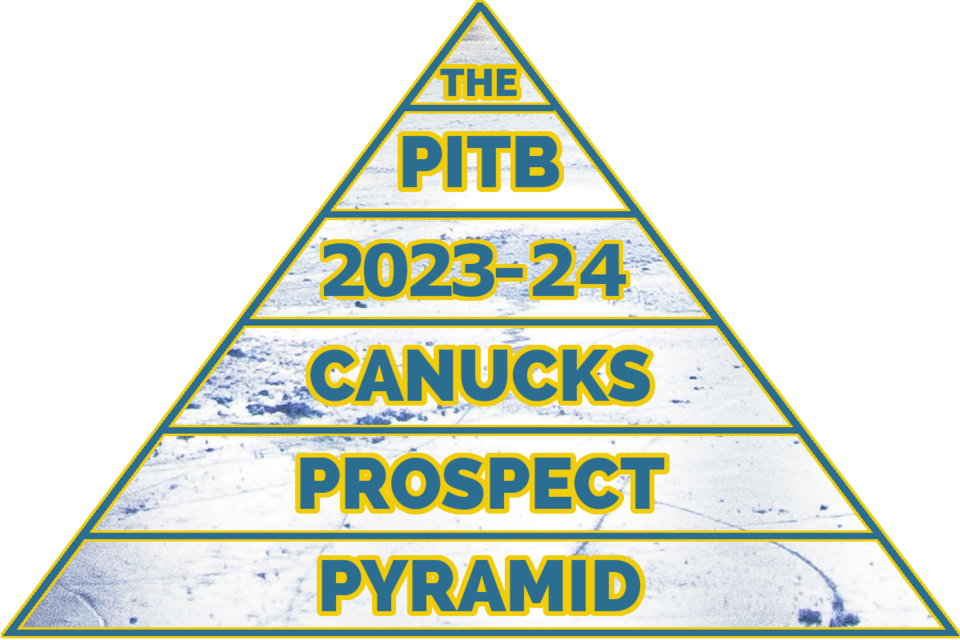It’s time for the return of one of the greatest architectural designs in human history: the pyramid.
Specifically, it’s time to rank the Vancouver Canucks’ prospects using a pyramid, as it is the best shape for doing. Haters will say that it’s not actually a pyramid — it’s just a triangle — but you can’t listen to your haters.
The prospect pyramid is borrowed from Toronto Maple Leafs content creator and professional yeller Steve Dangle. The point of the prospect pyramid is that trying to rank a team’s prospects using a list runs into problems because there’s not much point in trying to judge the differences in potential between prospects once you get past the first few.
The truth is, most prospects in a team’s system are approximately at the same level, so it’s more accurate to rank prospects in a tier system. The prospects ranked 10 through 15, for example, are probably about the same caliber of prospect and trying to decide which one makes the top 10 and which ones don’t doesn’t make a lot of sense.
So, the prospect pyramid takes the tiers of a team’s prospect pool and arranges them in a triangular shape. The pyramid is narrower at the top than at the bottom because there are naturally a limited number of top prospects and a ton of middling to okay prospects in a team’s system.
Tier 1 — so, this is awkward
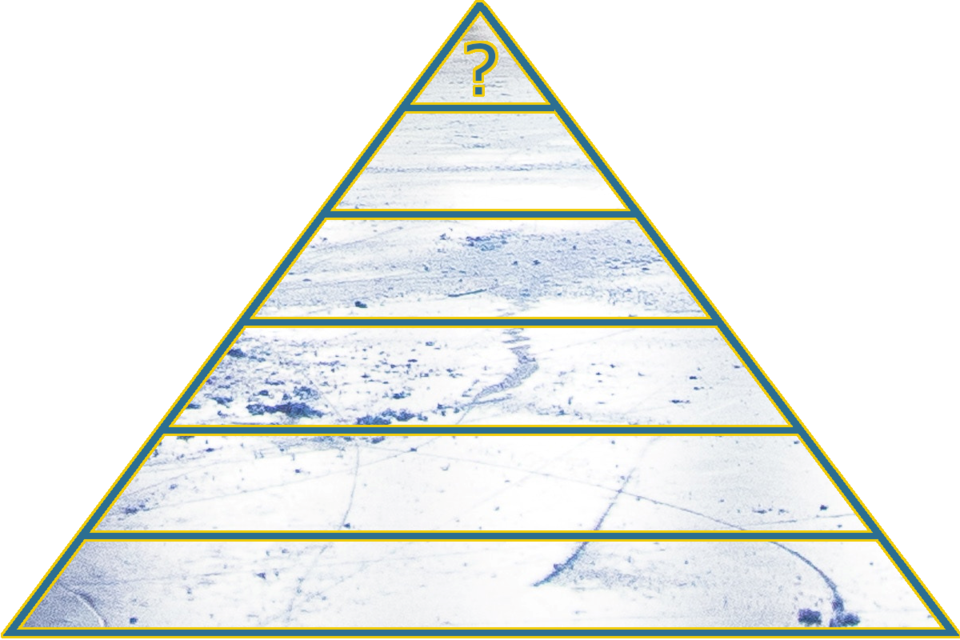
A Tier 1 prospect is a blue-chip, can’t-miss prospect. They’re the type of prospect that not only has the potential to become a first-line forward, top-pairing defenceman, or elite starting goaltender, but has an excellent chance to reach that potential. Even if they don’t, they’re basically a sure thing to at least be an NHL player.
Unfortunately, the Canucks don’t have anyone in that tier right now. They have good prospects with intriguing potential but no one that could be accurately described as a blue-chipper.
None of the Canucks’ prospects made The Athletic’s list of top 50 NHL prospects, nor did they make Elite Prospects’ similar list. They have a couple of prospects who are close and might work their way into the top tier with an excellent season but they’re not there yet.
Tier 2 — Lekkerimäki and Willander
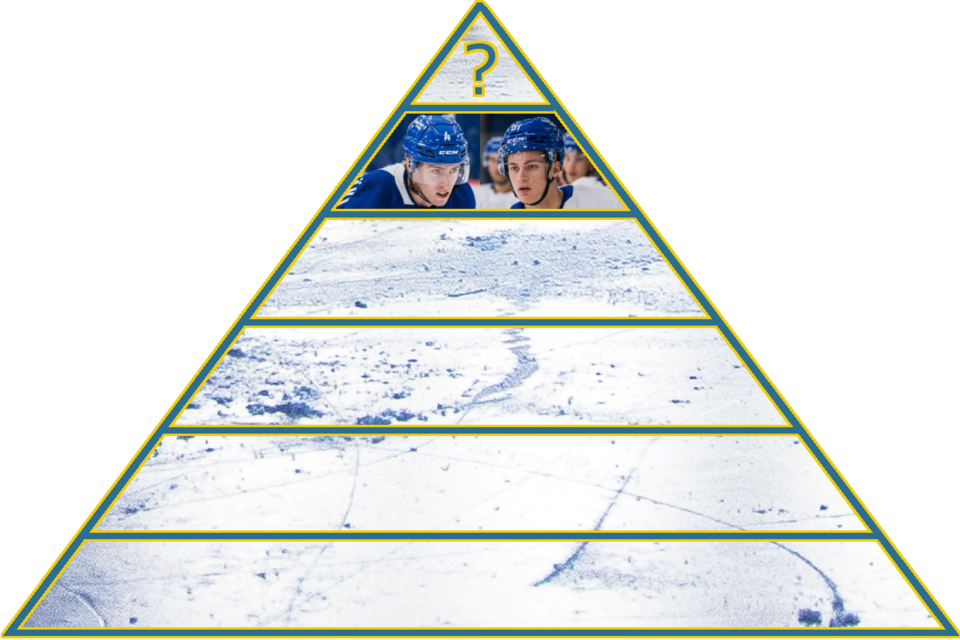
A prospect in Tier 2 has the potential to be a top-four defenceman, a top-six forward, or a starting goaltender in the NHL and a strong chance of reaching that potential. Maybe they’re not blue-chip prospects, but they could still become impactful players.
Jonathan Lekkerimäki was a tier one prospect last year, which may have been a little bit aggressive. Even when he was drafted, he wasn’t quite a blue-chip prospect like Elias Pettersson or Quinn Hughes were when they were drafted.
Then Lekkerimäki had a dismal post-draft season in which he battled mononucleosis and multiple injuries and struggled to produce in the HockeyAllsvenskan. The playoffs, however, were a different story, as he returned from injury and put up 15 points in 15 games for Djurgårdens. That glimmer of hope kept him in Tier 2, as he still has a good chance of becoming a top-six forward in the NHL.
The Canucks’ 2023 first-round pick, Tom Willander, has the potential to be a top-pairing defenceman with his flawless skating and strong defensive game. The one potential red flag that keeps him from Tier 1 is that he simply did not produce a lot of points in the J20 Nationell, Sweden’s top junior league.
If Willander can establish himself quickly as a great defenceman at Boston University in the coming year, he’ll look a lot more like a blue-chip prospect.
Tier 3 — Räty, Silovs, Pettersson, and friends
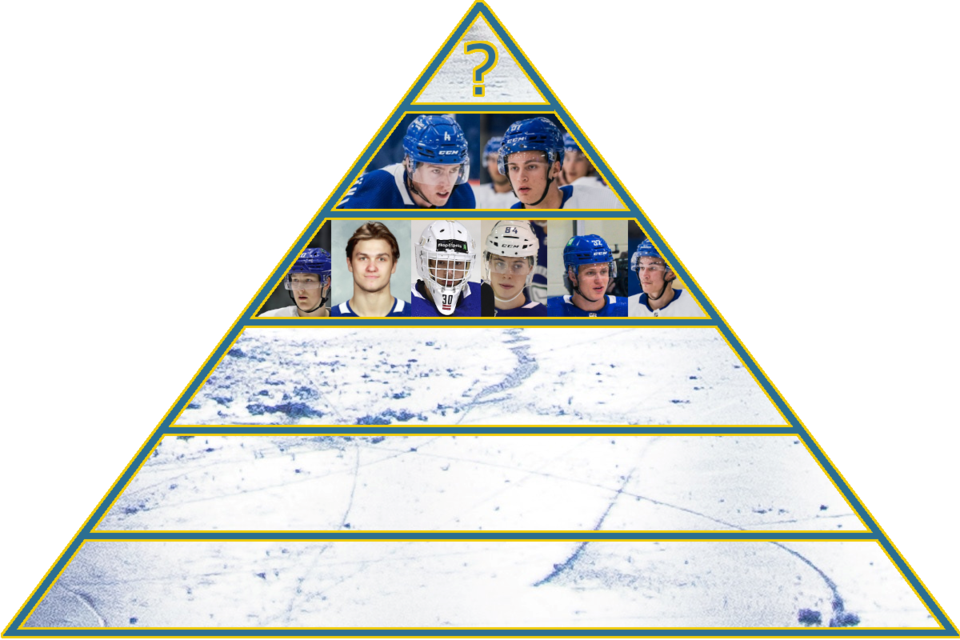
Prospects in Tier 3 have a good shot of becoming NHL players but they’re more likely to be a bottom-six forward, third-pairing defenceman, or a backup goaltender than a star. If they do have high-end potential, they’re more of a long shot to fulfill that potential.
It seems certain that Aatu Räty will be an NHLer. What is a lot less certain is how good he can be once he’s in the NHL.
The big issue for Räty remains his skating, which could prevent him from becoming a second-line centre or winger. It’s far more likely that he settles into a third-line role with his strong two-way game or possibly even fourth-line if his mobility limits his ability to match-up against opposing forwards.
Danila Klimovich is a fascinating prospect, as he has the size and skill to be a top-six power forward but needs a lot of work to get there. At 20, he’s already heading into his third AHL season and it would be great to see him take a major step forward from the 17 goals and 29 points he put up in 67 games last season.
Arturs Silovs has rocketed up the ranks after earning the starting role in the AHL for the Abbotsford Canucks last season, appearing in five NHL games, and earning MVP honours at the World Championship for leading Latvia to a bronze medal — the first IIHF medal in Latvian history.
With all that hype, it’s important to keep in mind that Silovs still only had a .909 save percentage in the AHL last season and still has a long way to go to becoming even a regular backup goaltender in the NHL, let alone a starter or true number one. That keeps Silovs in Tier 3 for now, but he’s still rising.
Aidan McDonough sneaks into Tier 3 as a bit of an edge case. He’s got size and an excellent shot, which led to some sterling statistics for Northeastern University in the NCAA. He could be a complementary middle-six winger with some power play utility, but his limited footspeed could hold him back. Already 23 and about to turn 24 in November, McDonough doesn’t have a lot of runway left as a prospect but may not need it.
Elias Pettersson — the defenceman, not the forward — is at the upper ends of Tier 2 after a very good season in the SHL for Örebro. He’s a smart, physical defensive defenceman and is set to play an even bigger role for Örebro next season. It would be nice to see him add a bit more offence to his game in the SHL, however, to prove that he has top-four potential in the NHL.
Akito Hirose caused a buzz in his brief NHL audition with the Canucks thanks to his calm demeanour and poised play in the defensive zone. He looks close to making the NHL but he better, as he’s already 24 years old. His underlying statistics were ugly in that small sample size, however, and he’s very slight for his 6’0” height, so he’s got work ahead of him. Still, he looks like a strong bet to get to the NHL.
Tier 4 — Rathbone continues to slide
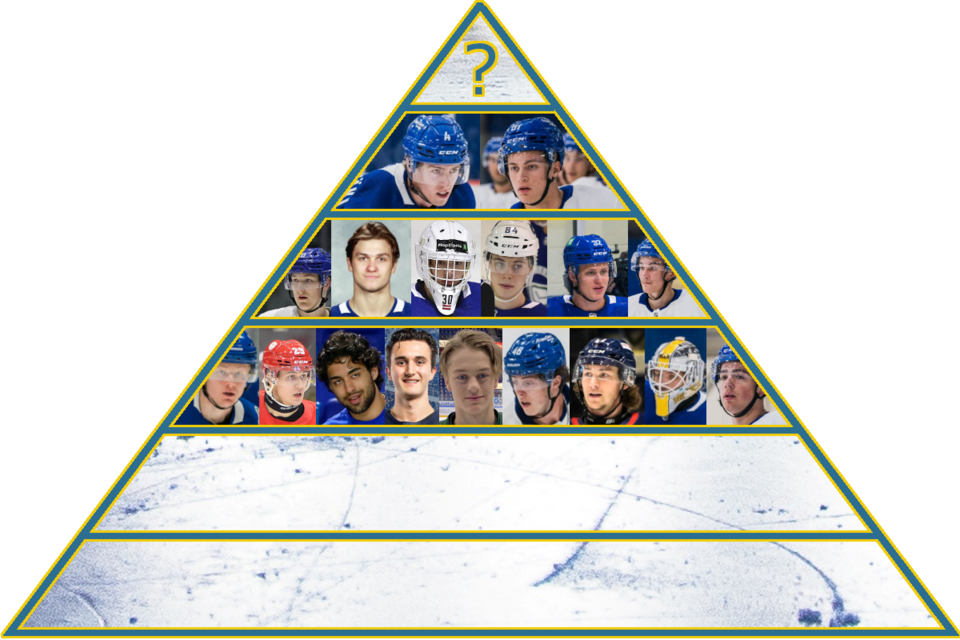
Prospects in Tier 4 might make the NHL but they have a long road ahead of them or a lot of uncertainty surrounding their potential. Maybe they’ll be a fourth-line forward, a seventh defenceman, or a bubble backup — maybe they’ll be more than that — it’s just not clear.
At one point, Jack Rathbone was the Canucks’ top prospect on defence. Two seasons ago, he piled up 40 points in 39 AHL games and looked poised to break through to the NHL.
Last season, however, Rathbone struggled in his stints in the NHL and failed to come even close to his previous scoring pace in the AHL. Rathbone is 24 now and is rapidly reaching not-a-prospect status. It’s entirely possible that he tops out as an AHL defenceman.
Kirill Kudryavtsev had a solid post-draft season after the Canucks took him in the seventh round in 2022. He improved his scoring to 50 points in 67 games, which was third in scoring on the Soo Greyhounds and 14th among OHL defencemen. There’s offensive potential there and he’s got some decent defensive tools.
Arshdeep Bains is a smart, driven young man, who has quickly become the pearl of the Abbotsford Canucks’ development system. Coming into the Canucks’ system as the WHL’s leading scorer, Bains quickly adapted his game to become a grinding, two-way penalty killer in the AHL, and that adaptability and coachability could see him get to the NHL sooner rather than later.
Jacob Truscott has quietly become a very good two-way defenceman in the NCAA for the University of Michigan. He’ll be the captain of Michigan in the coming season and will carry a much more significant load with Luke Hughes, his defence partner last season, heading to the NHL.
Lucas Forsell is outperforming the typical seventh-round pick in Sweden, with 11 goals and 13 points in 35 SHL games last season as a 19-year-old winger. That's the type of production at 19 that bodes well for an NHL future, as it’s similar to the likes of Jakob Silfverberg, Artturi Lehkonen, and Nils Höglander at the same age, but he still has a ways to go
Cole McWard has already scored his first NHL goal, but his brief NHL stint at the end of last season showed that there’s still work to do for him to make the NHL long-term. He needs work in the AHL, particularly in the defensive zone, but he could see NHL games next season if there are injuries. The question is his upside — can he be more than a depth defenceman?
Josh Bloom has the two-way game to potentially land in the Canucks’ bottom six in the future but he’ll need to prove himself in the AHL first. He’s got the speed to play in the NHL, at least, but needs to put together the details. The Canucks landed him in a trade for Riley Stillman, so he’s essentially a free prospect.
Nikita Tolopilo is a wild card — a 6’6” Belarusian goaltender, who excelled in the HockeyAllsvenskan last season. He needs to work on sealing up gaps in his stance, which isn’t unusual for such a big goaltender. He’s on his way to North America, where he could back up in Abbotsford but is more likely to get sent to the ECHL to play more games as a starter.
Finally, Hunter Brzustewicz is one of the Canucks’ best picks in the 2023 NHL Entry Draft, a third-round pick who looks a lot like he should have been a second-round pick. He’s great in transition and has legitimate offensive upside, but has some work to do on his skating, which lands him in Tier 4.
Tier 5 — Woo and Nielsen hope to graduate from Abbotsford
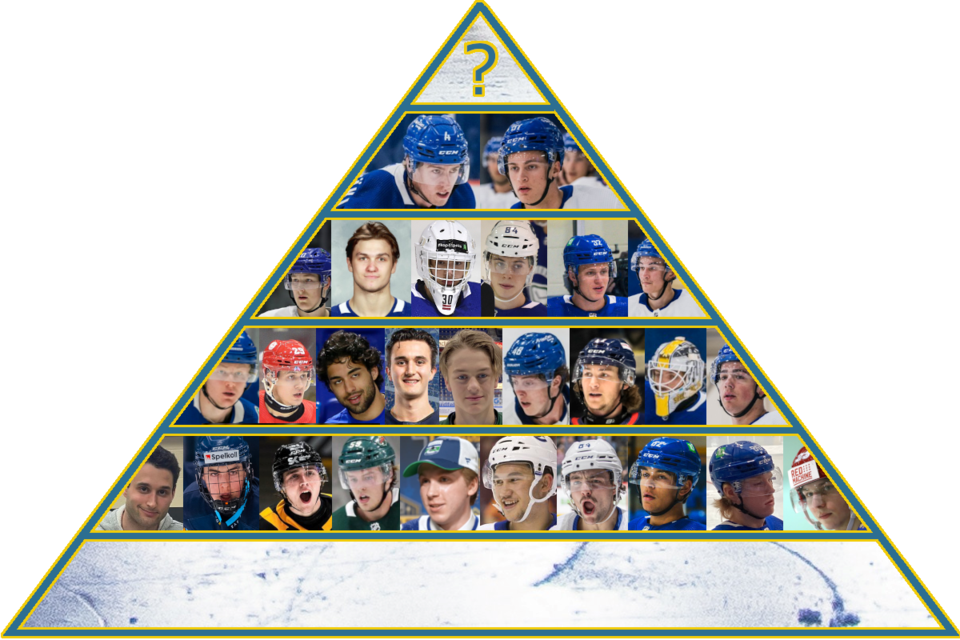
There’s nothing wrong with being in the fifth tier and some prospects might still surprise and work their way up the system. These are players whose potential leans towards being a bubble player — depth forward, depth defenceman, or AHL goaltender — but with the right development maybe they could be something more.
Heck, there are some prospects in this tier that might even play a game or two for the Canucks this season.
Max Sasson has the skating to play in the NHL and could potentially work his way into a bottom-six role for the Canucks. At the very least, he’s decent depth at centre.
Vilmer Alriksson is an intriguing project with his 6’6” stature and smooth skating but he’s still raw and needs to learn how to use his size effectively.
Linus Karlsson could be a call-up option for the Canucks this season after a solid 49 points in 72 AHL games last season. He’s also about to turn 24 and still has question marks surrounding his skating.
Filip Johansson couldn’t make the Minnesota Wild after they selected him in the first round in 2018 but he’s finally on his way to North America. He’s a longshot at this point but perhaps he can show something with the Abbotsford Canucks and prove that he can be an NHL defenceman.
Sawyer Mynio might have been a surprise pick in the third round for the Canucks but he’s an effective defensive defenceman in the WHL and has the tools to do the same in the NHL. The question is whether he can put together the puck skills to get there.
It’s been tempting to write Jett Woo off as a prospect in recent years but he turned things around last season with the Abbotsford Canucks, taking on a big role as a minute-munching, two-way defenceman. He was more physical, better at moving the puck, and popped in seven goals. Woo could conceivably play NHL games next season but the jump from the AHL to the NHL is a tough one and Woo’s development path has been very rocky so far.
Tristen Nielsen has become a fan favourite with the Abbotsford Canucks thanks to his speed, grit, and dogged determination. He’s a pain in the neck to play against, an adept penalty killer, and the type of player to light a spark in his team. The 23-year-old could be a call-up option for the fourth line this season, particularly since he’s versatile and can play all three forward positions, but it remains to be seen if he can be more than just a depth forward.
Jackson Dorrington is a physical defensive defenceman with solid size but has struggled to put up points, whether in the USHL in his draft year or as a freshman with Northeastern University, which is typically a bad sign about a defenceman’s ability to move the puck. Still, his defensive game was enough to get him some attention from Team USA at the World Junior Summer Showcase. He’s a longshot to make the World Junior team but it’s still a positive that he was invited to the showcase.
In training camp and practice situations, Joni Jurmo looks amazing. He’s big, fluid, and skilled, with all the tools to be an NHL defenceman. The question is whether his mind can catch up with those tools, especially as the pace of play quickens. The 6’5” Finn intends to play one more season in the Finnish Liiga, then come over to the AHL.
Dimitri Zlodeyev was a standout performer at the Canucks’ prospect development camp earlier this summer and has quietly been making progress in his game since he was a sixth-round pick in 2020. He has a two-year contract in the KHL, so won’t be coming to North America until the 2025-26 season, but could be a middle-six centre by that point.
Tier 6 — Everybody else
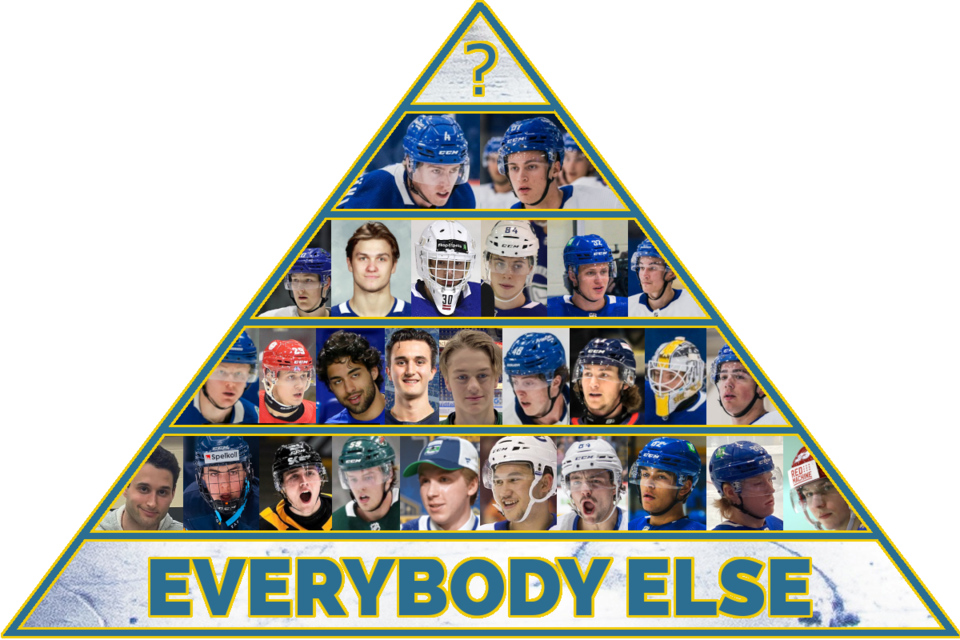
This is the tier for every other prospect in the system. The odds are against these players making the NHL but you never know. To the Canucks’ credit, the prospects they have in this tier seem more promising than in previous years.
The prospects from this tier that seem most likely to climb the tiers of the pyramid in the coming years are Aiden Celebrini, Ty Mueller, Daimon Gardner, Hugo Gabrielson, Aku Koskenvuo, and Ty Young.
